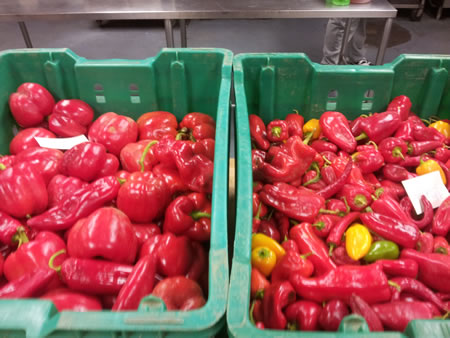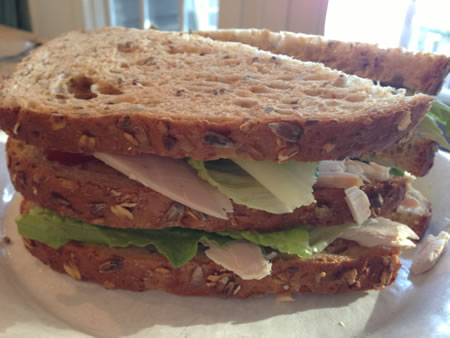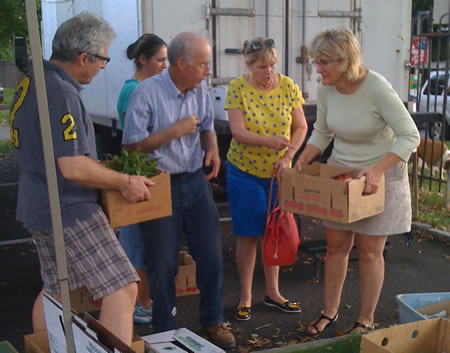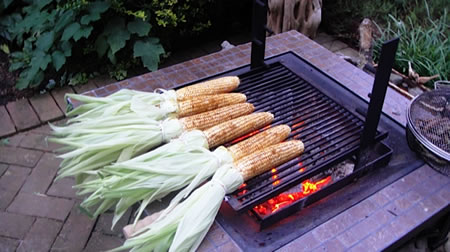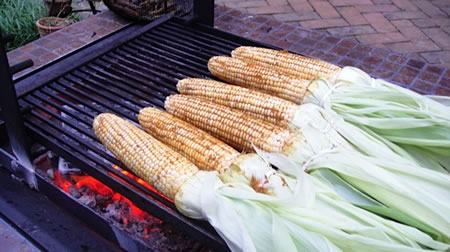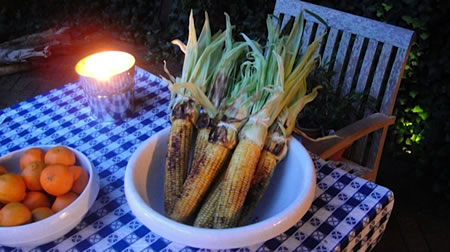By Laura
Josephine’s Feast! Wins Good Food Award 2013

Laura, June Taylor, Alice Waters at the San Francisco Ferry Terminal for the Good Food Awards 2013
What do you get when you bring the best artisan food producers in the USA into one room? The Good Food Awards, which marked it’s third year on January 18, 2013. Held at the San Francisco Ferry Building, the event is sponsored by The Seedling Project and was hosted by Alice Waters. And I am so very proud to say that Josephine’s Feast! was announced as a winner in the Preserves Category for our Hand Foraged Wild Beach Plum Preserves.

Good Food Award Medals 2013
This national award recognizes the highest level of achievement in producing artisan products that are both delicious and produced in a responsible manner using local and sustainable ingredients. 1,366 entries from 49 states were blind-tasted resulting in 100 winners across 9 categories. The complete list can be found on the Good Food Awards website.
The Awards Ceremony is a Black Tie Gala often referred to as the “Oscars of Food”. The Wall Street Journal columnist Kitty Greenwald remarked, “the Awards Ceremony puts a spotlight on people who are working hard to keep a pulse on what’s happening around the country…it means an exciting future for young entrepreneurs and for food quality nationally.”
The gala featured tastings of the winners food and dishes envisioned by 10 local chefs, including Sarah and Evan Rich of Rich Table, Comstock Saloon’s Carlo Espinas, Bill Corbett of The Absinthe Group, Trevor Ogden of Chambers and Slanted Door alum Grace Nguyen of Asian Box. Josephine’s Feast! Hand Foraged Wild Beach Plum was chosen by Chef Carlo Espinas of the Comstock Saloon for a Wild Beach Plum and Rye Whisky Cured Gravlax with Picked Creme Fraische.
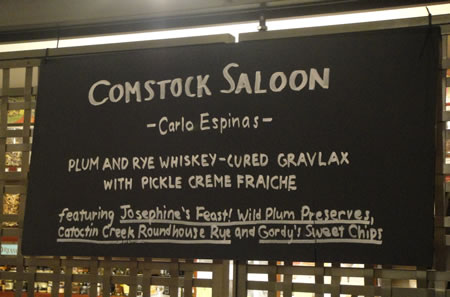
Carlo Espinas dish using Wild Beach Plum Preserve
It was a delicious evening, or rather a Delicious Revolution as Alice Waters would say. The beauty of the event was that like-minded producers were able to come out of their kitchens, smokehouses and roasting rooms and share their craft. We had the opportunity to speak with other food crafters and taste all the winners – which was no easy feat! Some of my personal favorites are listed below:
Vanilla Bean Salted Caramels –Her Coconess Confections , California.
Shelly is my new BFF and insists she was put on this earth to feed the world. Her caramels are outstanding and her Bittersweet Nibby Rocky Road ain’t bad either.
Black Sesame Brittle –Sweetdragon Baking Company , California
At Sweetdragon the Black Sesame Brittle is awsome and her New Crop Pistacio Brittle is also off the charts – in fact my brother and I almost got into a fight over the last piece
Tarragon Cherries – Cold Water Canyon Provisions , California
Rondo makes preserves from his mother recipes The pickled cherries were divine! The perfect pairing with a marscapone cheese or alongside roasted duck.
Japanese Pickle & Arame Kimchee – The Cultured Pickle Shop , California
June Taylor sent me to meet Alex, “Their Kombucha is outstanding”, and on that I was greated with the smell of fermenting krauts. The Pumpkin Kimchee is my favorite along with a Red Beet Kombucha.
Borselino Salami – La Quercia , Iowa
Kathy Eckhouse is an inspiration to anyone who handcrafts artisinal food. A gifted cook and mother, she and her husband Herb have built a business based on the good food and respect for all. I have been buying their proscuitto at Dean and Deluca for years but never realized how great they really are.
House Ham – The Meat Hook Brooklyn , NYC
Now this is ham!
Wild Thimbleberry Jam – American Spoon , Michigan
Larry makes a perfect wild preserve. Just lovely.
As for us, we would just like to thank all the people who bought our Wild Beach Plum Preserve in September and October before there was any awards or recognition. You bought it because you tasted it and you liked it, and it just goes to show you certainly have great taste!
Stalking the Wild Beach Plum
Here is a our story about the elusive Wild Beach Plum.
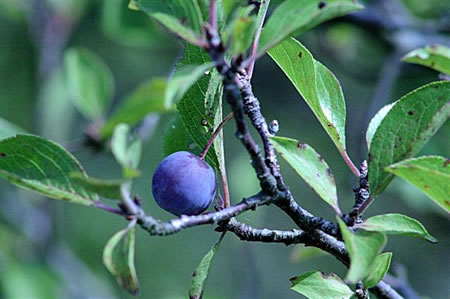
Prunus Maritima is a member of the rose family and often confused with rose hips by the uninitiated. Beach plums grow along the seashores of the Atlantic coast from Eastern Canada to Virginia.
They range in size from a small Nicoise olive to a giant Sicilian olive. But they have a huge pit – and often more suited to jelly making than that of a true preserve. They are a finicky plant, producing an overwhelming abundance one year and almost nothing the next.

Ron G - The Forager
Another problem is where to find them. No true forager reveals their sources. In fact, when asked where the beach plums are found, almost unanimously the answer is “if I tell you I will have to kill you.” Our forager is a third generation farmer and carpenter from East Hampton who gleefully brought a hundred or more pounds of beach plums to me 3 years ago. Ron G keeps a little book with “his” foraging haunts and has brought us wild beach plums, wild grapes, wild cherries and wild cranberries. He fights the ticks and the poison ivy and I really think he loves this work.
There was such a bounty that first year. We had no idea what to do with all the beach plums. Ron made jelly from his mother’s recipe and I began experimenting with preserves. We made beach plum liquor and liquor soaked beach plums. I even pickled some. The following year, after Huricane Irene, the bushes were barren. This year, the harvest was a pretty good one if you got to them before the other foragers. You also have to beat the deer who are known to eat beach plums.
The taste is a cross between a plum and a prune with a heady tang and an especially deep flavor.
As I began selling this preserve at the markets, my customers shared family stories of parents dragging bands of children onto the beaches with pails to pick the beach plums – they only produce fruit along the bay and the ocean. Farmers and bankers alike, all making jam and jelly over the years.
The preserve making is time consuming. First you wash,sort and pit. Then I mix the berries with cane sugar and let them macerate over night in a true method confituer – this helps to develop the natural pectin. Cooking is also tempermental. The fruit gels only when the proper balance of water to sugar to fruit pectin is reached. Then we hand jar, vacuum seal in a water bath, cool and label our preserves.
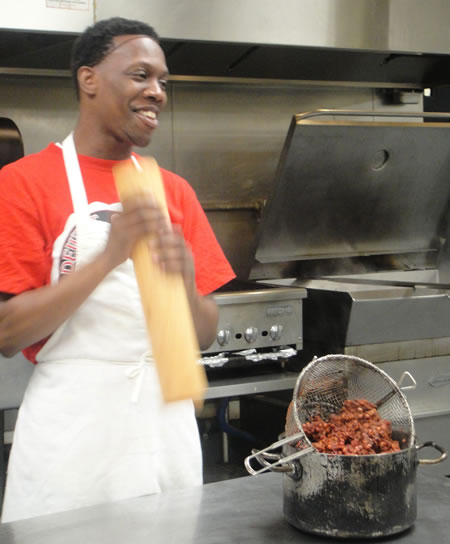
Eli in the Kitchen processing the Beach Plums after Food Milling
In an effort to better understand the beach plum I registered for a class at the New York Horticultural Society in the Fall. It was given by Gary Lincoff who has foraged with Euell Gibbons himself over the years. His talk was wonderful and his book is even better – The Joy of Foraging. I highly recommend it, especially if you want to add a little purslane to your salad, but that is a conversation for another day. Gary finds beach plums along the coast of New York City and Long Island. He pits the plums with an antique cherry pitter – because, “it still works as good as anything.” He served his Beach Plum Preserves over a ricotta cheese cake. Couldn’t be better.

Gary Lincoff at the New York Horticultural Society - 2012
Josephine’s Feast! – Good Food Awards Finalist
 We couldn’t be happier to share some good news with you. Josephine’s Feast!’s Hand Foraged Wild Beach Plum Preserves has been named as a finalist in the 2013 Good Food Awards in the Preserves Catagory. The awards will be announced in San Francisco on January 18, 2013 at the historic Market Place in the San Francisco Ferry Building. The Black Tie event will be hosted by Alice Waters and is considered to be the Oscars for food producers in the US. You can read the Good Food Awards Press Release here. There where over 1300 entries, from 49 states. Only 16 companies from New York State where chosen as finalists. Wish us luck!
We couldn’t be happier to share some good news with you. Josephine’s Feast!’s Hand Foraged Wild Beach Plum Preserves has been named as a finalist in the 2013 Good Food Awards in the Preserves Catagory. The awards will be announced in San Francisco on January 18, 2013 at the historic Market Place in the San Francisco Ferry Building. The Black Tie event will be hosted by Alice Waters and is considered to be the Oscars for food producers in the US. You can read the Good Food Awards Press Release here. There where over 1300 entries, from 49 states. Only 16 companies from New York State where chosen as finalists. Wish us luck!
Giving Thanks for Turkeys, Leftovers and Hurricane Hot Pepper Preserves

Unconcerned Wild Turkeys in Southampton - Thanksgiving 2012
Thanksgiving is that easy holiday – it feels as comfortable as a warm fire on a cool fall evening. A bit more laid back than most – it has always been my husband Sean’s favorite day. A casual feast with family and friends – what could be better?
After the upheaval of Sandy – I feel the exact same way. A loss of power and a few days stuck at home is a small price to pay when so many have lost so much – we all have something to be thankful for. At Josephine’s Feast! our cooking schedule was disrupted for a week. Hurricane Hot Pepper Preserves were on the schedule and is something I love to make. Just after Irene hit last year, Quail Hill Farm in Amaganset had an amazing assortment of hot peppers standing defiantly on the vine long after the hurricane had left. I thought the peppers were outstanding little devils to resist the storm and set out to harvest all that I could. In the kitchen our first vintage of Hurricane Hot Pepper Preserves was born. And it was amazing.
I waited patiently this year watching the peppers ripened on the vines on the farm and placed a substantial order with Kate the market manager at Quail Hill. We worked together at the Montauk Farmer’s Market and I told her that I had great plans for a second vintage of Hurricane Hot Pepper Preserves. I would take all the hot peppers that I could get – not realizing that history was about to repeat itself
As the day approached for my pick up, the frankenstorm was looming. Kate assured me the peppers were would be fine in her care. Packed away in refrigerators. The storm hit and it hit hard wiping out electricity on long island and nyc. It took us a week but Sean and my brother Chris finally picked up the peppers. They were just maganificent – as was Quail Hill Farm, a testament to the miracle of mother nature.
They trucked a couple hundred pounds of red hot peppers to my kitchen in Astoria, and my my staff & I car pooled over the 59th street bridge to slice, pickle, cook and preserve – what we all do best.

We had sweet red peppers that were so perfect it was hard to cook them – they were a masterpiece of beautiful crimson set against bright green crates. We had green and red jalepenos that we picked in a brine that was scented with anise and coriander. We had Habernaro and Pardon peppers – a Spanish hot pepper that I had never worked with. Tasting it mindlessly I realized it was far hotter than I expected and it burned my lips but had a delicious flavor. I would balance the heat of the Habernaro with the Pardon Pepper in a new preserve – a Red Hot Chili Pepper Jam. The color is a glorious red and the heat is quite strong.
And then there were the chilis – waiting to be sliced simmered in an apple cider based preserve. That would become out second vintage of the Hurricane Hot Pepper Preserve. Sean jokes that we might want to name it “After the Hurricane” – I thought why not?
My team and I cooked, crafted and packed the hot peppers into the most wonderful preserves. And in the end absolutely nothing tastes better with a plowman’s lunch or a Double Decker Hurricane Hot Peppered Preserve Turkey Club Sandwich. This delicious mayonnaise blend is absolutely simple and turns Thanksgiving leftovers into a FEAST!
Double Decker Hurricane Hot Pepper Preserve Turkey Club Sandwich
1/4 pound Sliced Turkey Breast – leftover from Thanksgiving is best
3 slices of Rye Bread
Mayonnaise
JF After the Hurricane Hot Pepper Preserves
Romaine Lettuce
Sliced tomato
Toast the bread
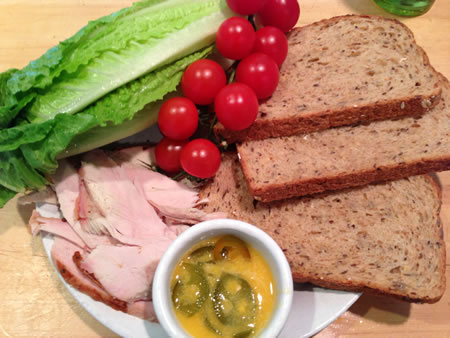
- Salt & pepper the turkey breast. My husband likes to heat the turkey slices in the pan which I find most delicious.
- Add 2T of Mayonnaise to 1T of JF After the Hurricane Preserves and mix well.
- Pull off 4 to 5 leaves of romaine and slice the tomato extra thin
- Spread the mayonnaise/pepper preserves on two slices of bread and stack bacon, turkey, tomato and romaine in that order. Add a second slice of bread and repeat finishing off with the last and final slice of bread.
- Enjoy the Feast!
Way Down Yonder in the Papaw Patch
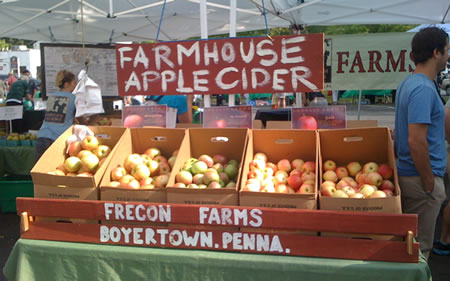 I love markets and when I am traveling, I often find myself being drawn to gourmet shops, food markets or farm stands. London is remarkable, Paris is legendary, Venice is on the canal and Northern California has no equal. But as Dorothy stated while she clicked her ruby heels, ‘There is no place like home.” And when I opened my eyes, I found myself just outside of Philadelphia visiting our friends.
I love markets and when I am traveling, I often find myself being drawn to gourmet shops, food markets or farm stands. London is remarkable, Paris is legendary, Venice is on the canal and Northern California has no equal. But as Dorothy stated while she clicked her ruby heels, ‘There is no place like home.” And when I opened my eyes, I found myself just outside of Philadelphia visiting our friends.
The Dixon’s settled on the Main Line after traveling around the world for a year. It is a short train ride on the Keystone Rail Road leaving Grand Central in NYC. Our visit meant our families would have some time together talking, bonding and cooking up a feast – after all we had to test drive the new kitchen and well, cooking is in our blood. Vincent, Ainlay and I gathered up our girls and their son and set off to the Bryn Mawr Farmers Market early Saturday morning
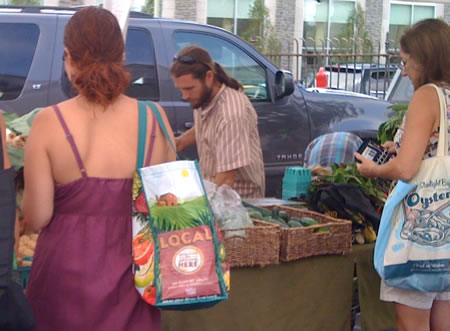
The market is pristine – where else can you find carefully made and exceptionally delicious Pumpkin Pie Hummus? This is a foodies market – cooks who cook and farmers who farm. Smart people who eat and live well. Organic produce was at its peak. Tomatoes and corn, peaches being bought up by the bushel box for home canning. Responsibly reared grass fed lamb, pork and beef with handmade sausage punctuating the offerings. Chickens & eggs are displayed alongside potatoes as big as baby’s heads and as tiny as a penny. All perfect in their own right.
In the back of this Pennsylvania market was a fruit I had never seen or tasted in my life. As a child I had sung the praises of this fruit in a nursery school song that had stuck in my head for a good portion of my years. It went something like this “scooping up papaws and put them in the basket.’ In reality, I have never tasted or even seen a Papaw.
The farmer told me it was one of two fruits native to the US and that we could, “Scoop the pulp and eat the same food as Pocahontas.” That statement went a long way with our three daughters all under the age of 10. Actually, its not true, but it is the largest Native American Fruit in North America.
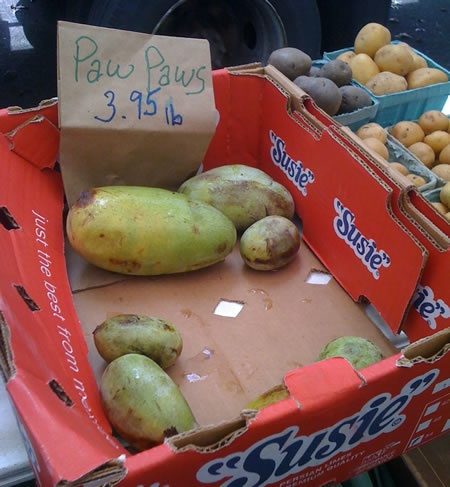
Thomas Jefferson grew them at Monticello and it is documented that Lewis and Clark ate papaws on their expedition west. In fact Merriwether Lewis’s recorded this passage in his journal on September 15, 1806 , “We landed one time only to let the men gather Pawpaws or the custard apple of which this country abounds, and the men are very fond of.”
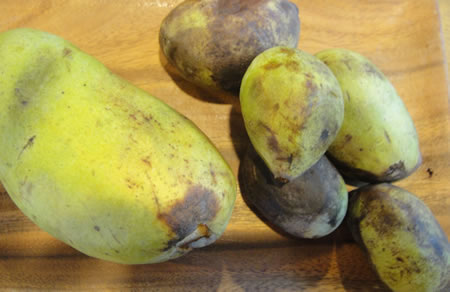
Well they certainly don’t look like much – but Lewis was wise to make the stop, the chartreuse colored fruit reminds me of something tropical – mango, papaya with a hint of banana. The fruit has three times as much vitamin C as an apple, twice as much riboflavin & niacin as an orange, and about the same potassium as a banana. High in magnesium, iron, manganese and copper, it’s a good way to imbibe protein – papaws contain all essential amino acids. In fact food researchers consider papaws a super food.

“When its soft it’s ready”, I couldn’t argue with the farmer who had grown papaws all his long life I made a fuss and purchased just all the fruit he had left. His grandson who worked the stand thought I was nuts. I probably am – but just a little.
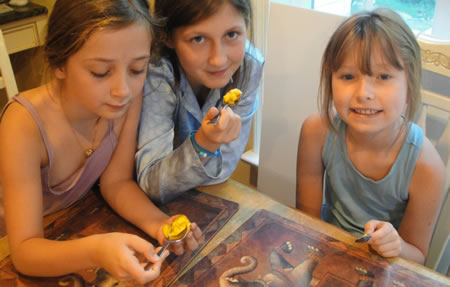
When we ate the papaws there were mixed reviews. The texture is soft a bit like a mango – I could easily see papaw sorbet, smoothies or dare I say preserves. The color ranges from a chartreuse to a pale persimmon. It could be used in place of apple sauce alongside potato pancakes or with a roast. But honestly that farmer was right – it is best just scooped out of the skin and eaten fresh from the market. A seasonal treat that our three daughter’s thoroughly enjoyed.
As Summer Ends, So Does the Corn
A Light Wind Swept over the Corn, and nature laughed in the sunshine.
-Anne Bronte
Anne Brontë was a British novelist and poet, the youngest member of the Brontë literary family. Rather poetically, as I guess the only way a Bronte could be, she writes about corn fields in England. And this is the time of year that all conversations in our Farmer’s Markets are poetically devoted to corn. I find fresh picked corn just about the best thing in the world. Cooked simply on the grill, corn defines the summer season.
But we do reach our limits, and as the season ends, I can’t help experimenting with various herb butters and spice rubs when we bring home fresh picked corn from the Farmer’s Market . One of my favorite ways to extend my interest in the harvest is to roast or grill the corn over the fire, enhancing it’s flavor with herb butters or spice rubs. Shucking the ears and tying the husks to use as a “handle” is key, and it makes a beautiful presentation at your barbecue as well as on your table.
I have to admit any fresh herb butter will do – gather what you have in your garden if you are lucky enough to have one – oregano, thyme, coriander or anything you may have on hand. Finely chop the tender herbs and add a pinch of sea salt blending with butter to make a paste. Alternately a tablespoon of dried sage, thyme or crushed rosemary will do. Grease the corn with the herb butter and set on the grill. Roll a few times to cook all sides and serve. Do not over cook – 3 to 5 minutes is more than enough time.
Alternatively – I make a curry rub that is sensational with grilled corn. I love the way the warmth of the chili and spices flavors the corn and enhances each kernel’s sweetness. Grill to taste and to get a nice roasted color.
Simple “Curry Rub” for Corn
2 T Mild Curry Spice
1 T Dried Thyme
1/4 t Sea Salt – more of you prefer
Good quality Olive Oil
- Mix all three ingredients in a bowl
- Shuck each ear and brush with olive oil
- Rub a good amount of “curry rub” into the corn.
- Grill over BBQ coals or an open fire.
At Josephine’s Feast! we have Bridgehampton Curry Rub for Corn on the Cob that works well on corn as well as grilled vegetables – such as zucchini, squash, carrots or potatoes and even Shrimp. Give it try!
The Wonderful Blue Cheese Wedge
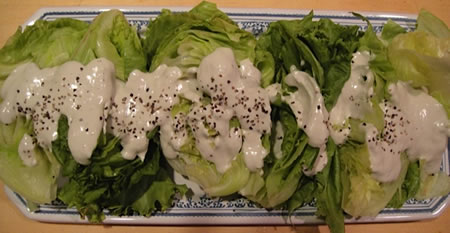
In the market, iceberg lettuce conjures up two insanely different images. The first is the iceberg of my childhood memory. A bowling ball of watery leafy greens that were just about mummy wrapped in cellophane and saran wrap on the A&P shelf and served on a plate with a dollop of plain sour cream by my Aunt Josie. She was not a cook but an exceptional God Mother and Aunt.
The second was hand harvesting my first head of heirloom iceberg at Quail Hill Farm. What a treat – so much so that I’d drive 20 miles to harvest the iceberg when the crop comes in. I dare not share my secret of the exceptional flavor of the heirloom iceberg while other share holders pick the deer tongue, boston, and other fancy lettuce heads. I wanted to be able to pick more next week. And inevitably the iceberg was still there – week after week.
Now the fun begins. I love an impecable wedge – not the the Baco’s covered wedge of restaurant chain fame – but a proper blue chesse wedge salad – with or without bacon.
My second secret is a recipe from Montrachet – where the blue cheese dressing was made with buttermilk and tarragon vinegar. Exceptional by my standards.
For this recipe – you will need a gadget. A wand is perfect but a blender or small food processor will do.
Butter Milk Blue Cheese Wedge Salad
3 small heads of heirloom iceberg lettuce – or 1 large head
1 cup of Butter Milk
1 large shallot – I prefer the torpedo shaped shallots, they are easier to peel
8 to 12 oz of Danish Blue cheese
1T tarragon vinegar. And although any good quality herbal vinegar will do – the taragon vinegar imparts the perfect flavor
Coarse Ground Black Pepper for Finishing
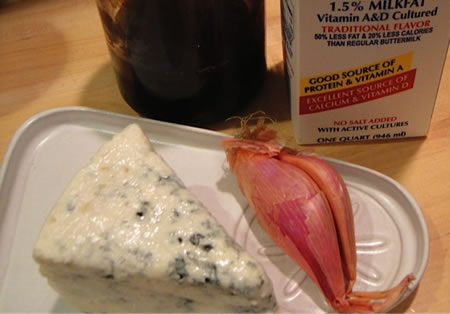 1-Measure the butter milk and set aside.
1-Measure the butter milk and set aside.
2-Roughly chop the shallots by hand.
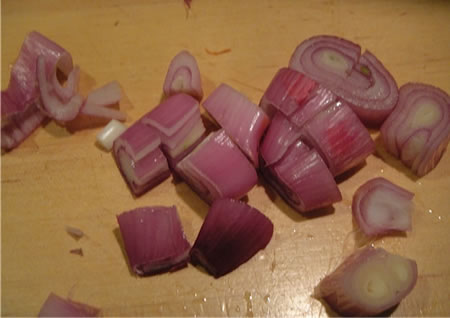 3- Add the shallots and the vinegar to a vessel and process to chop.
3- Add the shallots and the vinegar to a vessel and process to chop.
 4- add the buttermilk and process adding cheese chunk by chunk continuing to process into a thick dressing
4- add the buttermilk and process adding cheese chunk by chunk continuing to process into a thick dressing
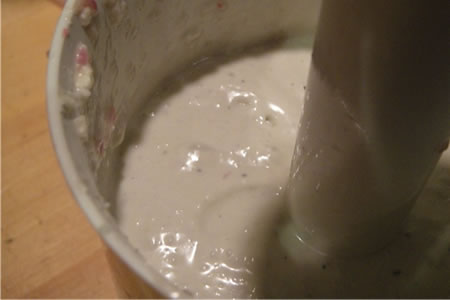 5- Taste. Drizzle in more vinegar if need be.
5- Taste. Drizzle in more vinegar if need be.
6- Refrigerate
7- Just before serving cut the Iceberg lettuce heads into wedges. I like the smaller heads on a long platter – lined up like soldiers on guard
8- Spoon the Buttermilk Blue Cheese Dressing over the wedges making sure it is distributed evenly. Finish with Coarse Ground Black Pepper to taste.
Buttermilk Blue Cheese Dressing is a teriffic sauce over grilled skirt steak as well. And makes a lovely main course salad.
On Making Lemonade

My daughter Josephine often sells an organic lemonade on Sunday’s at the Southampton Farmers Market. And in the City, her friends Noah and Micayla have a stand on Mercer Street in Soho where they cornered the market on one of the first 99 degree days of summer. Who can resist?
Both refreshing and satisfying – hand making lemonade is as good for the soul as it is for drinking on a hot summer day. It’s easy to do , and can be made in no time at all. Further, the customization possibilities are endless. Sliced strawberries, cherries, and even mellon balls can be added for a seasonal blend. Mint sprigs or lavender honey produce something a bit more sophisticated – maybe lending itself to a splash (or more) of vodka or even tequila.
For the best lemonade – there are a few steps to follow to guarantee a superb result.
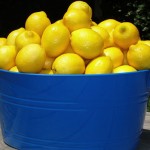
Ingredients
12 organic lemons
1 cup sugar
Filtered water
Ice
1 – Roll the lemons between the palm of your hand and the counter – this action breaks down the fibers making the juicing a bit easier and some say it renders more juice.
2 – Cut the lemons in half and squeeze – it you have an electric juicer or a group of friends this goes faster. I use on old corning glass citurus juicer – suits me just fine.
3 – Bring 2 cups of cold water to a boil and dissolve the sugar.
4 – Add the strained juice of the 12 lemons – or simply remove the pits and keep the pulp – your choice.
5 – Add two scoops of ice to a heat stable pitcher & pour the lemonade “syrup” over ice. This will cool down the temperature of the “syrup”.
5 – Adding more cool water and additional ice to fill the pitcher.
Options (and they are endless)
• Mint springs or muddled mint
• A splash of orange juice to further sweeten the lemonade
• A hand full of berries – it gives the lemonade a pink glow.
• Sliced cucumber and/or fresh coriander
• Mellon or watermelon balls
I like to make a cocktail using fresh lemonade a few slices of serano chili and tequila – garnish with a cucumber spear & corriander. Very refreshing on a hot day.
Fava Bean Bruschetta
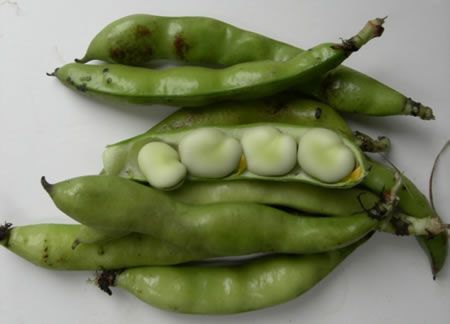
All of a sudden it hits – the markets are loaded with greens of all kinds. The bounty is overwhelming – but what I focus in on is the arrival of the Fava Beans. For me it means summer has begun.
To eat fresh Fava Beans in the early summer is the ultimate treat. They can be added to pasta or served with salt and a nice bottle of chianti as Mr Lecter may have suggested – you may want to save the liver for another day. They taste green & fresh, just perfect for a summer lunch along side a simple green salad or sliced tomatoes.
Easy to make – cooking fava beans takes some planning. You will have to peel the pods releasing the Fava Beans from the shell. I’ve had grilled Fava Beans served in the shell – but that is quite simply another recipe and should only be attempted with the freshest youngest beans. My favorite way to eat these delicious delicacies is as a brilliant green Fava Bean Bruschetta.
Fava Bean Bruschetta
2 Lbs Fresh Fava Beans
1/3 c Olive Oil plus additional oil – I prefer fresh green just pressed oil for this dish
pinch of Sea Salt
1 Organic Lemon
2 cloves Garlic
1 Baguette
1 – Shell 2 lbs of fresh Fava Beans – look for young green pods
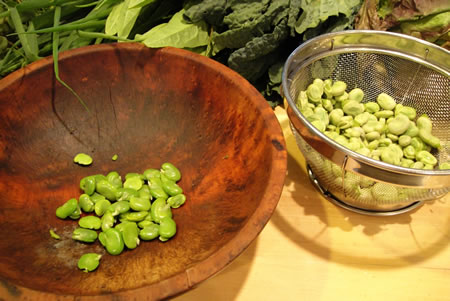
2 – Blanche the beans in a pot of salted water – a minute or two is sufficient. You want to be able to peel the beans from the shell
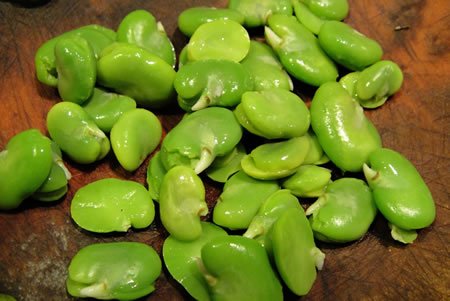
3 – When all the beans are shelled reserve in a bowl and place 1/3 cup of olive oil in a pan with a pinch of sea salt.

4 – Add the beans to the pan a quickly sauté until soft.
5 – Zest the lemon – reserve
6 – Cut the lemon in half and squeeze juice into the fava beans
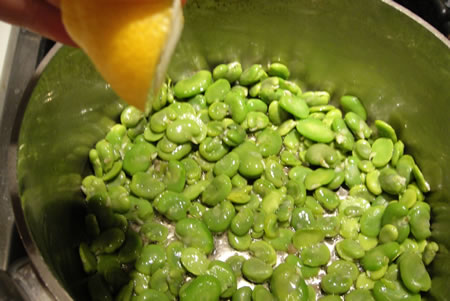
7 – Mash with a fork or better yet am immersion blender for a finer puree. You may need to add a dash of olive oil to soften the puree.
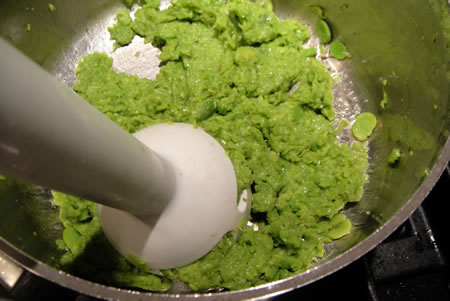
8 – Slice the baguette
9 – Toast the bread – this tastes even better if you can grill it on an open fire.
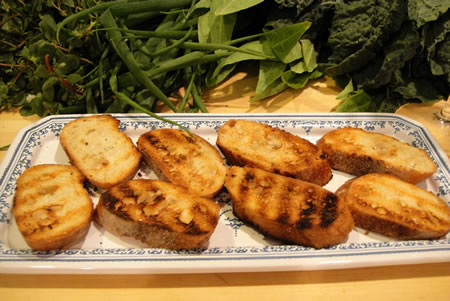
10 – Rub with a raw garlic clove on one side for a subtle flavor or both sides for a more robust garlic taste.
11. Spread the puree on the toast – you can drizzle additional olive oil over the top and sprinkle with the reserved lemon zest.
Serve with a green salad or sliced tomatoes. Just perfect with “a nice bottle of Chianti”

How to Eat a Fiddlehead Fern

After writing my post on Ramps my dear friend Nancy Hume an actress, a teacher, and old Yankee at heart reminded me of the glories of seasonal cooking by reminiscing about her mothers Spring meals that were foraged in the fields of Martha’s Vineyard. The season started with Ramps and moved through Fiddlehead Ferns and Garlic Scapes. She still spends summers in her family home in the Vineyard and someday I’ll harvest wild grapes there. As all good foragers, she has her secret locations that she promised to take me to.
We had a wonderful discussion on Fiddleheads, comparing notes on how to serve them – it can be very simple – just sauté and eat. The Fiddlehead is a great source of Vitamin A & C and has a well rounded mineral content. Picked while still rolled in a coil before the fronds unfurl, you have to soak and wash the soil from the coiled fern. Although they are green and crunchy and are perfect sautéed – I like to feature this seasonal woodland delicacy as a main dish served over pasta or as a memorable main course salad.
Fiddlehead Ferns & Trumpet Mushrooms over Baby Spinach
2 Baskets of Fiddle heads
1 lb. Assorted Mushrooms
I used two Japanese varieties of Trumpet mushrooms – a Trumpet & a King Trumpet
2 T Olive Oil – or the oil of your choice
1 T Sesame Oil
Squirt of Yuzu Juice (if you have it)
Fresh Baby Spinach
1 – Clean the fiddlehead ferns by soaking them in water for a few minutes and rinsing the soil from the coils. Dry on paper towels. Cut off the dry stems – they often are tough.
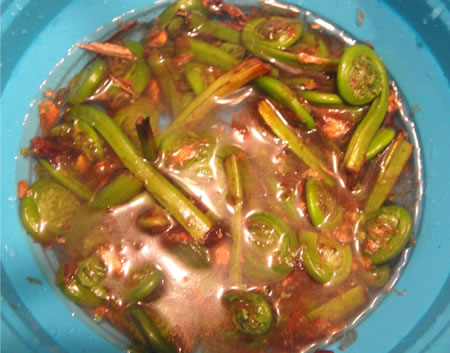
2 – Wipe the Trumpet Mushrooms clean – slice the King Trumpets length wise in insure even cooking.
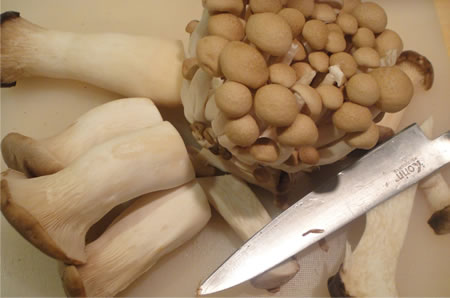
3 – Add 2 T Olive Oil to a heavy sauté pan or wok – I use an antique cast iron pan that was my husband’s grandmother.
4 – First sauté the King Trumpet Mushrooms – they need more time to soften.
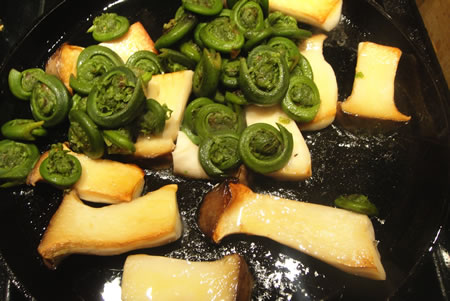
5 – When they begin to soften and turn a bit golden add the Fiddleheads. Give them a minute or two to cook and then add the smaller Trumpet Mushrooms.
6 – Quickly add 2 T of Soy Sauce – I use a low sodium. Cook one minute more.
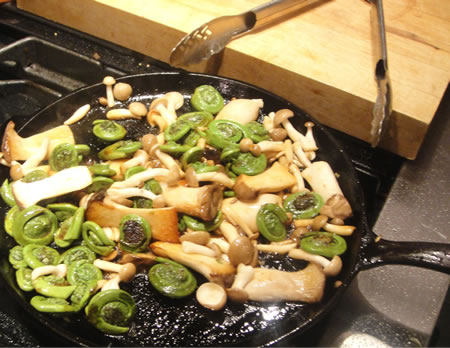
7- Just before service – add 1 T of Sesame Oil. I like the flavor very much Alternatively you can add a squirt of Yuzu Juice or Lemon if you are watching your fat/oil intake.
8 – While hot from the pan, layer over Baby Spinach greens.
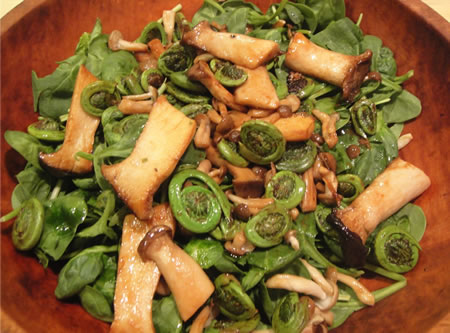
9 – Served with garlic bread or Parmesan toast points this salad makes for an exception summer lunch.

